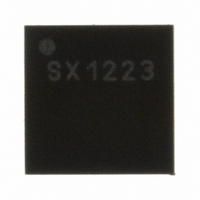SX1223I073TRT Semtech, SX1223I073TRT Datasheet - Page 12

SX1223I073TRT
Manufacturer Part Number
SX1223I073TRT
Description
IC TX UHF 433/868/916 MHZ 24TQFN
Manufacturer
Semtech
Datasheet
1.SX1223SK433.pdf
(25 pages)
Specifications of SX1223I073TRT
Frequency
425 ~ 475MHz / 850 ~ 950MHz
Applications
AMR, Home Automation, HQ Music and Data
Modulation Or Protocol
FSK
Data Rate - Maximum
153.6 kbps
Power - Output
10dBm
Current - Transmitting
25.8mA
Data Interface
PCB, Surface Mount
Antenna Connector
PCB, Surface Mount
Voltage - Supply
2 V ~ 3.6 V
Operating Temperature
-40°C ~ 85°C
Package / Case
24-TQFN
Lead Free Status / RoHS Status
Lead free / RoHS Compliant
Features
-
Memory Size
-
Other names
SX1223I073TR
4.2.3
4.2.4
The bit rate is set by first dividing the crystal oscillator frequency by an integer in the range [1..63] in a
programmable divider, then this frequency is divided further by powers of two. The equation describing the bit rate
as a function of RefClk_K and BRn is
where:
f
RefClk_K:
BRn:
A procedure to determine the settings for the desired bit rate is described below:
1. Set BRn to 0.
2. Calculate RefClk_K by using this formula:
3. If RefClk_K is too high, increment n by one, and repeat step 2, above
In some cases several combinations of RefClk_K and BRn will provide the required bit rate. In these cases BRn
should be chosen with the following in mind: A lower BRn offers better waveform shaping or spectral efficiency, but
may cause modulator saturation at some bit rates.
Frequency deviation is controlled by user parameters RefClk_K, MOD_I, and MOD_A together with physical
parameters f
when designing in the radio chip. K
user.
The crystal oscillator frequency, f
clock is controlling the rise and fall times for the modulator, the frequency deviation is inversely proportional to this
clock. The relationship is shown in equation (4.2).
It is assumed that K will be constant for most applications to keep bit-rate and shaping constant, although this is not
a requirement.
The control parameters of the frequency deviation are MOD_I and MOD_A. Of these two, MOD_I is the parameter
that controls the signal generation, while MOD_A controls attenuation of this signal. The reason for using an
attenuator is to be able to generate small deviations at high values of RefClk_K. The relationship is shown in
equation (4.3).
Finally, the VCO gain is given by equation (4.4).
where:
Const
Const
f
FreqBand:
© Semtech 2007
XTAL
C
:
:
1
2
:
:
Bit Rate Setting for MW1 and MW2
Deviation Setting for MW1 and MW2
BR
K
f
f
DEV
VCO
DEV
XTAL
Re
Const
Re
Crystal oscillator frequency.
Integer in the range [1..63] (6 bit).
Integer in the range [0..5] (3 bit).
Carrier frequency.
Frequency band. 0: 400MHz and 1: 900MHz.
fClk
54
and K
MOD
2
f
30
fClk
7 .
XTAL
MOD
f
_
1
XTAL
.
K
6324
_
VCO
_
Const
K
_
2
A
3
2
I
. All user parameters can be set in software, and f
BRn
2
FreqBand
10
f
C
9
XTAL
2
VCO
, is divided by RefClk_K to generate the modulator clock. Since this modulator
FreqBand
(VCO gain) is a parameter of the radio chip, and is not controllable by the
Re
fClk
_
K
12
BR
f
XTAL
2
3
BRn
.
XTAL
(crystal oscillator frequency) is set
(4.1)
(4.2)
(4.3)
(4.4)
www.semtech.com
SX1223












